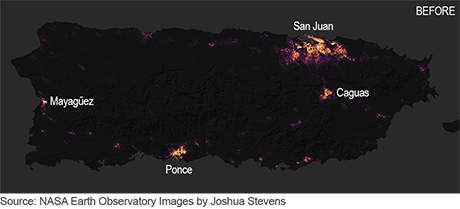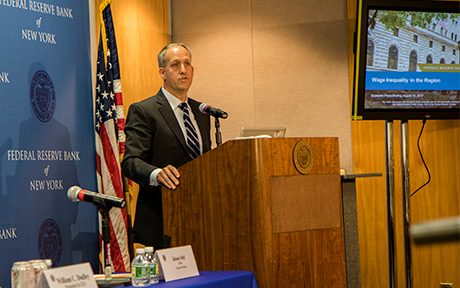Beginning to Gauge Maria’s Effect on Puerto Rico’s Economy

Just two weeks after most of Puerto Rico dodged the proverbial bullet, missing the brunt of Hurricane Irma, the island was devastated by Maria—one of the ten strongest Atlantic hurricanes on record. Making landfall on September 20, 2017, the storm caused not only massive physical destruction and tragic loss of life but also widespread and persistent power outages, shortages of potable (and even nonpotable) running water, and disruptions to telecommunications and travel, among other issues. With the storm boosting costs and disrupting activity, the short-term economic impact is clearly significant. But an even greater concern is that the adverse short-term effects of the storm, overlaid on an already shrinking economy, may evolve into long-term adverse effects. In this post, we focus on the magnitude, duration, breadth and nature of the economic disruptions, as measured mostly by employment.
How Is Online Shopping Affecting Retail Employment?
Just Released: Economic Press Briefing Focuses on Regional Wage Inequality

The New York-Northern New Jersey region is home to some of the most and least unequal places in the nation, based on research presented today at our economic press briefing examining wage inequality in the region. Wage inequality—meaning the disparity in earnings between workers—has increased significantly in the United States since the early 1980s, though some places have much more wage inequality than others. Fairfield, Conn., for example, ranks as the most unequal metropolitan area in the country, and the New York–Northern New Jersey metropolitan area ranks in the top ten. On the other hand, most of the metropolitan areas in upstate New York are among the least unequal places in the country.
Just Released: June Regional Business Surveys Paint a Mixed Picture

Yesterday’s June Empire State Manufacturing Survey pointed to a significant increase in regional manufacturing activity. However, our parallel survey for the region’s service sector, the June Business Leaders Survey, released today, paints a somewhat dreary picture of regional service-sector activity. These two surveys, taken together, suggest that economic conditions in the New York-Northern New Jersey region are mixed.
Just Released: The Regional Economy Is off to a Good Start in 2017

The New York Fed’s latest Beige Book report, released this afternoon, shows the regional economy gathering steam in early 2017. The report, based on information collected through February 17, suggests the regional economy, which had been essentially flat for the second half of 2016, saw growth pick up to a modest pace at the start of the year. Manufacturers, in particular, note a sharp rise in activity, as do businesses in wholesale distribution and transportation. Consequently, the market for industrial and warehouse space was pretty robust in the opening weeks of 2017. Meanwhile, businesses in most service industries continue to report steady to moderately expanding activity. And even though consumer spending has remained fairly subdued, consumer confidence climbed to highs not seen in more than a decade. All in all, it appears the regional economy has gotten off to a good start in 2017.
Just Released: Regional Business Surveys Point to Growth in Economic Activity

The latest editions of the New York Fed’s two regional business surveys point to improvement in business conditions and widespread optimism about the near-term outlook. The December Business Leaders Survey of regional service firms, released today, shows service sector activity steadying after declining for a number of months, and the December Empire State Manufacturing Survey, released yesterday, indicates that manufacturing activity increased for the first time since the summer.
Lower Manhattan since 9/11: A Study in Resilience
The 9/11 terrorist attack on the World Trade Center left a deep scar on New York City and the nation, most particularly in terms of the human toll.
What Caused the Decline in Interstate Migration in the United States?

Geographic mobility is thought to be important both for economic mobility and for the efficiency of a labor market in allocating the right people to the right jobs. Accordingly, the willingness of the U.S. workforce to move is a factor behind the greater dynamism of the U.S. labor market compared to Europe. While Europeans tend to be more reluctant to move to distant places within their respective countries, the idea of moving across state borders for a job has been woven into the fabric of the American Dream. However, the image of the United States as a mobile nation has changed substantially over recent decades. This post investigates the role that demographic shifts—in particular, the nation’s aging population—have played in the recent decline in interstate migration.
Just Released: Job Growth in the Region
At today’s economic press briefing, we provided an update on regional economic conditions, with a particular focus on job growth in the region, and highlighted an important emerging labor market trend: the return of middle-wage jobs.












 RSS Feed
RSS Feed Follow Liberty Street Economics
Follow Liberty Street Economics